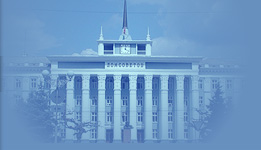Local Administration of the town of Tiraspol
Tiras is an ancient name of the river Dniester.
From the earliest times along the Dniester there was a merchant road to the Crimea, Turkey and then to the East. There were other names of the river: Tupas, Danastus, Tinestra, Turla. The movement of caravans were interrupted with wars being waged in this territory during the centuries. Before joining Russia (1791) the territory of Pridnestrovie was the part of Turkish Ochakovskaya province where Tartars were wandering.
The town on the river Dniester arose as a result of wars of Russia against the Ottoman Empire in the 18-th century. In the course of the war (1787-1791) Russian troops under the command of Suvorov A.V. gained some brilliant victories. The war was ended with signing the Yassky Treaty on “eternal peace and friendship” and the lands between the Buge and the Dniester (present Pridnestrovie) passed to Russia. In 1792 it was decided to build a fortified line for defence of the western border of Russia. Originally Tiraspol was founded as a fortress Sredinaya that served for important military and strategic functions. Moldavians engaged in fishing founded a small village Sukleia on the left bank of the river (“it was burnt by Turks, but after the end of the war it was rebuilt).
The fortress was laid with the participation of Suvorov A.V. on June 22 (July 6) 1793. None the less 1792 is considered to be the date of the foundation of Tiraspol. Its name consists of two words: “Tiras” – ancient Greeks called the Dniester; and “polis” – it means “town” in classical Greek. Kahovsky V.V. and F.P de Volan are worth marking for their contribution to the construction of the fortress. To the east of the fortress a suburb arose that in 1795 became the town and centre of the region. Later the military value of the fortress decreased, but it was rather important for trading and economy. The town became a centre of Novorossiyskaya province (in 1796), then Nikolaevskaya province (in 1802), and Hersonskaya province (in 1806). In 1826 the fortress was declared to be the second-rate fortress and in 1835 it was abolished. The town was extended; some neighbouring villages became its part.
During the 19-th century the local industry (tallow-melting, candle-making, wine-making, brewing and other branches) was in great progress.
The rail building stimulated the economic development. It was built between 1867 and 1873.
Tiraspol became an important transport junction of railways, highways and waterways. At the end of the 19-th century there were 100 large and small enterprises that produced goods (the sum of 400 000 silver roubles). The production was sold at three large fairs. Merchants came there from all over Russia.
At the beginning of the 20-th century the town had a population of 35 200 people. Soon the town was involved in revolutionary events. In January, 1905 the committee of the Russian social democratic workers’ party was formed in the town. Workers, peasants from neighbouring villages and soldiers of Tiraspol garrison took an active part in the revolutionary movement.
After the revolution of 1917 the life in the small town had undergone great changes. Trade unions, Soviets of deputies and many political parties were organized. On March 12, 1917 the Soviet of workers’ deputies was established. Both workers and petty bourgeoisie were the members of the executive committee. In September 1917 the Bolshevist organization was formed in Tiraspol. Under the influence of Bolsheviks Tiraspol Soviet decided to establish the Soviet power in the region. On January 11, 1918 Tiraspol revolutionary committee was formed with a view to establish the Soviet power in the town and district. Meanwhile, Romania started intervention. The Special Army of Odessa garrison (later it was reorganised into Tiraspol detachment) was organised with a view to repulse Romanian forces. Tiraspol became a strong point of the revolutionary army.
Tiraspol was under threat of Romanian troops that had settled down in Bendery. But our troops managed to defeat occupants. In March, 1919 the Peace Treaty between RSFSR and Romania was signed.
During the Civil war Tiraspol was occupied by Austria, Germany and France. On February 12, 1920 the brigade under the command of Kotovsky G.I. liberated the town.
It was very difficult to restore the town and its economy. The population reduced, enterprises and transport means didn’t function, and roads were destroyed. There was a great lack of fuel, foods and clothes.
The first session of the All-Ukrainian Central Executive Committee made a resolution of the formation of the Moldavian ASSR as a part of the Ukrainian SSR. At first Balta was the capital of the republic. Then Tiraspol became the capital of the new Moldavian ASSR that stimulated its economic growth and cultural development. The town became a large industrial centre of the region. Local canneries and wine-making enterprises were known in many places of the USSR. The economic growth made favourable conditions for the cultural development. In 1930 the first higher educational institution – the pedagogical institute was established. In 1932 the High Communist School and the fruit and vegetable institute were open.
Soon first national creative collectives: the Moldavian playhouse, the choir “Doina”, the symphonic orchestra and other creative associations arose.
In August, 1940 the capital of the new-formed Moldavian SSR was moved to Kishinev.
When the Great Patriotic war broke, troops of the Red Army, Tiraspol garrison and irregulars were holding German and Romanian fascists in check during some weeks. On August 10, 1941 the town was captured by the enemy. It had been under the occupation for 3 years.
At that time the territory of Pridnestrovie became the part of Transnistria. Tiraspol was a centre of Transnistria between August 19 and October 17, 1944.
On April 12, 1944 Tiraspol was liberated by the troops of the 37-th Army of the 3-d Ukrainian Front. Tiraspol was awarded the Order of the Patriotic war of the first degree for courage and determination of Tiraspol-dwellers during the war. As well as other cities that had been under the occupation Tiraspol suffered a great damage (460 million roubles). The total number of population reduced from 50 000 (in 1940) to 11 000 people (in 1944).
The restoration of the town started soon after the liberation. The industry had achieved pre-war rates by 1951. Old enterprises were reconstructed, new ones were built. During the post-war period development of the housing and cultural infrastructure, educational and national health affairs were paid much attention to.
Some new enterprises (a glass-tare making factory, an electric equipment factory, “Elektromash”, a metal-lithography factory, a cannery of children’s nourishment, furniture-making factories, a souvenir mill, “Moldavizolit”, an auto refrigerator factory, a cotton mill) and new housing units arose.
Between the end of the 1980-s and ’90-s Tiraspol became one of Pridnestrovian centres of striking and political resistance to the nationalism. On September 2, 1990 Tiraspol became the capital of PMSSR.
This town was famous for its foundations and traditions, its governing bodies were headed by experienced specialists. The Provisional Supreme Soviet of the Republic and later the Supreme Soviet of the Pridnestrovian Moldavian Republic conducted meetings in Tiraspol.
Tiraspol became the residence of the government and President of the Pridnestrovian Moldavian Republic according to the Edict of Chairman of PMSSR on July 22, 1991.
Nowadays Tiraspol is a large transport junction. It has a highly developed potential - 50 enterprises. Among them there is the Moldavian hydro-power plant, the joint-stock company “Elektromash”, the closed joint-stock company “Moldavizolit”, the joint-stock company “Tochlitmash” named after Kirov, the closed joint-stock company “Tirotex”, the wine and cognac-making factory “KVINT”, the joint-stock company “Odema”, the agro industrial firm “1 May”, the glass tare-making factory and brickworks, also some woodworking enterprises and furniture- producers. All of them export their production to CIS and foreign countries.
Tiraspol is also a scientific and educational centre of the republic. The Pridnestrovian State University occupies leading positions in the system of education. There are also some filiations of higher educational institutions of Russia and the Ukraine and the agricultural scientific research institute in Tiraspol. 20 secondary schools, a high school, 3 lyceums, 2 educational centres, 7 sports schools, etc. are functioning in the town.
The system of national health services includes 20 clinics with 3 000 doctors and nurses.
There are also a great number of institutions of culture in Tiraspol.
On October 14, 2002 Tiraspol celebrated its 210-th anniversary. In honour of this event it was awarded with “The Order of the Republic” according to the President Edict. In 1971 and in 1985 it was awarded the Order of Labour Red Banner and the Order of the Great Patriotic War of the first degree.
The local administration of the town of Tiraspol was established in accordance with the law of the Pridnestrovian Moldavian Republic “On local authorities and administration in the Pridnestrovian Moldavian Republic” and the President Edict “On the head of the local administration”. The Head of the local administration who directs local executive and administrative bodies is a supreme official in the town.
Pridnestrovian Moldavian Republic, Tiraspol, 25 October Street, 101
Phone: 373 533 31455, 373 5333 33315




